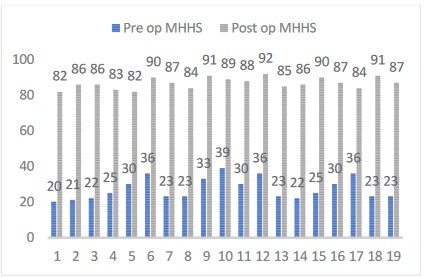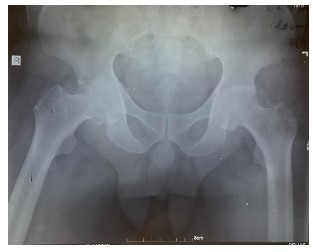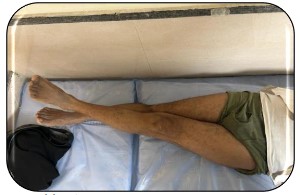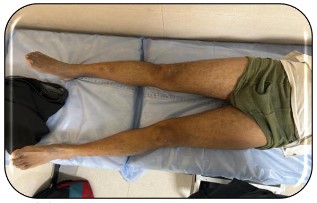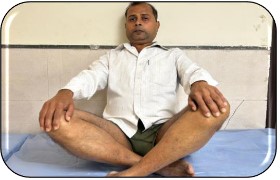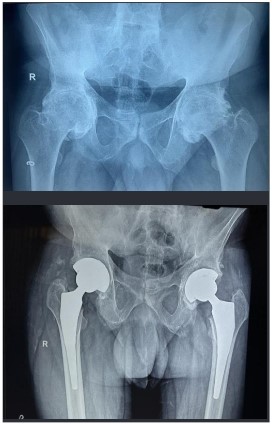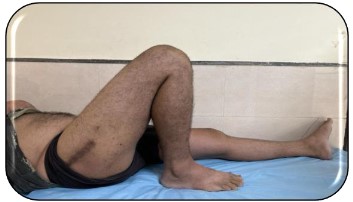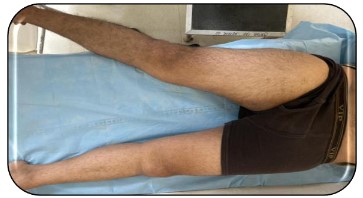Introduction
Ankylosing Spondylitis (AS) is a chronic inflammatory type
arthritis that forms part of the group of spondylarthritis. It firstly influences the spine and pelvis but peripheral arthritis and
enthesitis are also frequent features [1].
The mean age of onset of symptoms is between 15 and 25
years and it is more common in males [2,3]. Approximately
0.1% to 1.8% of people are affected.
Approximately 25%-50% of patients have hip joint involvement, with bilateral hip disease seen in 50%-90% of in AS [4].
Severe disability and functional impairment can result rapidly due to a combination of axial spine and hip involvement [1].
Due to abnormal spinopelvic mobility pattern that occurs
while changing posture from standing to sitting position, the
patients are unable to sit comfortably.
Disease-Modifying Anti-Rheumatic Drugs (DMARDs) such as
such as anti-Tumour Necrosis Factor (TNF) agents can slow the
progression of the disease but their role have been limited in
treating established arthritis of the joints [3].
Ankylosing spondylitis is a major indication for mobile total
hip replacement to reduce pain, restore hip joint function and
improve the quality of life.
Methodology
Study design: Retrospective
From May 2018 to Aug 2021, total hip arthroplasty was performed on 40 hips in 20 patients with bilateral ankylosis caused
by ankylosing spondylitis. The study patients included 14 men
and 6 women. All patients had severe hip pain and dysfunction
with bilateral bony ankylosis and no range of motion preoperatively.
The inclusion criteria were all patients with diagnosis of Ankylosing spondylitis with bilateral stiff hip. The exclusion criteria
were active infection, severe medical comorbidities, abductor
insufficiency and progressive neurological disorder.
Preoperatively, routine blood investigation and pre anaesthetic checkup was done. Preoperative mMHHS was calculated
and the score of worst hip was taken into consideration. X-ray
templating was performed to carefully plan the anatomical reconstruction and determine the most appropriate approach depending on patient anatomy. CT scans and 3-D reconstruction
were performed in some cases. First-generation cephalosporins
was administered 30 min before the operation and these antibiotics were re-administered for operations exceeding 3 hours.
All operative procedures were performed in an operating
room equipped with a vertical laminar-flow clean-air system.
All patients underwent bilateral THA performed by a single
surgeon using Hardinge approach keeping cup inclination and
anteversion in Lewinnek safe zone. The most severely affected
hip was operated on first, contralateral hip replacement being
performed 2-3 weeks later.
Post operatively prophylactic parenteral antibiotics were routinely given, as stated above, with one dose preoperatively and
continuation for 3 days postoperatively. Cephalosporin antibiotics were chosen to better prevent infection with gram-negative
organisms. Prophylaxis for deep vein thrombosis was given.
Patients were ambulated with weight bearing as tolerated.
Patients were evaluated at a mean follow up of 2 years and
Modified Harris Hip score was assessed during follow up.
Results
There were 20 patients (14 male, 6 female) with 40 affected
hips. The average patient age at surgery was 43.45 years old.
At a mean follow-up of 2 years, all patients had experienced
significant clinical improvement in function, ROM, posture, and
ambulation. At the final follow-up, the mean postoperative flexion ROM was 134.4° compared with 0° preoperatively. Similar
improvements were seen in hip abduction, adduction, internal
rotation, and external rotation. Post operatively all the hips
were pain free.
The mean pre operative mMHHS was 26. (20-39)
The mean post operative mMHHS was 86.95. (82-92)
The average improvement in mHHS was 59.8
No stem had loosened at the final follow up in any patient,
nor had any revision surgery been required.
Age distribution
Discussion
Ankylosing spondylitis is a chronic rheumatologic disease
which affects 0.8% to 1.8% of the population [2]. Hip involvement in AS is between 25% and 50%, and the disease may be
bilateral in 50%-90% of patients [4]. Disabling pain is the most
common indication for THA. Patients with bony ankylosis usually do not have pain, but functional limitation and presence
of severe deformity can be indications of THA in AS. Bilateral
THA appears to be a successful procedure in AS patients with
advanced hip disease. There are marked improvements in functional outcomes in the form of mHHS scores and range of motion in all the papers reviewed. Our study involved 40 hips in 20 patients with an average follow-up of 2 years. Our aim is to
assess the functional outcome using modified Harris Hip score.
In our study, the mean pre operative mMHHS was 26. (20-39)
and the mean post operative mMHHS was 86.95. (82-92). The
average improvement in mHHS was 59.8. In study conducted
by Feng D-X, Zhang K, Zhang Y-M, et al the mean preoperative
mHHS and the mean postoperative mHHS was 23.7 and 65.8
respectively. In another study conducted by Ye C, Liu R, Sun C,
et al the mean preoperative mHHS and the mean postoperative
mHHS was 24.8 and 83.8 respectively. The choice of cemented
or un-cemented implant is important for long-term outcome
and implant survival in this young patient group. Recent literature has shown that un-cemented prosthetic designs have the
potential of bone ingrowth and may increase the implant survival rates [5]. In our study we have used uncemented stems.
No stem had loosened at the final follow up in any patient, nor
had any revision surgery been required.
Conclusion
Our study shows that bilateral total hip arthroplasty is a safe
and effective treatment of advanced hip disease in AS. It results
in significant improvements in objective outcome measures
such as mHHS and patient mobility. This study shows that uncemented prostheses that have good post-operative results despite Ankylosing Spondylitis patients were found to have severe
osteoporosis in the upper femur. This treatment is worthwhile
surgical intervention and boom to patients who can barely walk.
Case 1
Flexion
Adduction
Abduction
Cross leg sitting
Case 2
Flexion
Abduction
Adduction
References
- He C, He X, Tong W, et al. The effect of total hip replacement on
employment in patients with ankylosing spondylitis. Clin Rheumatol. 2016; 35: 2975-2981.
- Feldtkeller E, Khan MA, van der Heijde D, van der Linden S, Braun
J. Age at disease onset and diagnosis delay in HLA-B27 negative
vs. positive patients with ankylosing spondylitis. Rhematol Int.
2003; 23: 61-66.
- Hou LQ, Jiang GX, Chen YF, et al. The comparative safety of TNF
inhibitors in ankylosing spondylitis: A meta-analysis update of
14 randomized controlled trials. Clin Rev Allergy Immunol. 2018;
54: 234-243.
- Bangjian H, Peijian T, Ju L. Bilateral synchronous total hip arthroplasty for ankylosed hips. Int Orthop. 2012; 36: 697-701.
- McLaughlin JR, Lee KR. Total hip arthroplasty with an uncemented tapered femoral component in patients younger than
50 years. J Arthroplast. 2011; 26: 9e15.
